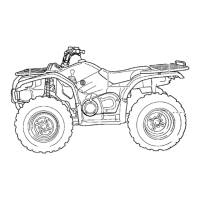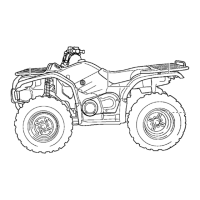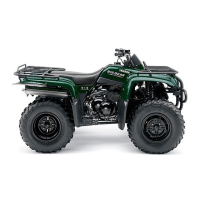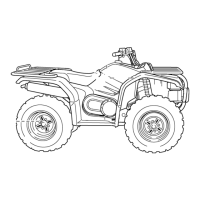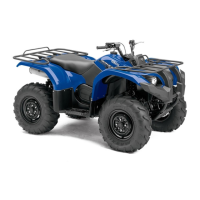Do you have a question about the Yamaha YFM45FAR and is the answer not in the manual?
Explains the structure of the service manual, including chapter titles, section titles, and sub-sections.
Defines the meaning of various symbols used throughout the manual for chapters, specifications, and lubrication points.
Details on identifying the vehicle's serial number and model label for parts ordering and reference.
Highlights key features of the vehicle, such as the liquid-cooled engine, park position, and front differential.
Provides crucial guidance on preparation for removal, replacement parts, and handling of specific components like gaskets and circlips.
Instructions on how to inspect and ensure proper continuity and connections of electrical connectors.
Lists and illustrates specific tools required for tune-up and assembly to prevent damage from incorrect tools.
Provides overall vehicle dimensions, weight, engine type, displacement, bore/stroke, and starting system details.
Details on engine, chassis, and electrical specifications, including limits and standard measurements for various components.
Specifies standard torque values for common fasteners with ISO pitch threads.
Identifies specific lubrication points on the engine and the recommended lubricant types for each.
Illustrates the flow of coolant through the system, showing the path from the radiator to other components.
Diagrams showing the path of oil circulation through the engine, including the camshaft, crankshaft, and drive axle.
Diagrams illustrating the correct routing of various cables and hoses throughout the vehicle.
Outlines recommended maintenance intervals and lubrication schedules for various vehicle components.
Procedures for removing and installing seat, side panels, front carrier, bumper, fender, and fuel tank.
Instructions for removing and installing the left and right footrest boards and brackets.
Covers checks and adjustments for engine components like valve clearance, idling speed, and spark plug.
Procedures for adjusting brakes, checking fluid levels, and inspecting chassis components like tires and wheels.
Guidance on checking and maintaining electrical components such as the battery, fuses, switches, and lights.
Step-by-step instructions for removing the engine, including air ducts, muffler, and exhaust pipe.
Procedures for removing, checking, and installing the cylinder head, tappet covers, and timing chain components.
Instructions for removing, checking, and installing camshaft, rocker arms, valves, and related components.
Procedures for removing, checking, and installing the cylinder, piston, piston rings, and related parts.
Details on removing, disassembling, and checking the recoil starter, A.C. magneto, CDI, and starter clutch.
Instructions for removing, disassembling, checking, and assembling the primary and secondary sheaves.
Procedures for removing, checking, and installing the clutch assembly, including the one-way clutch bearing.
Steps for removing starter motor, timing chain, oil filter, separating crankcase, and checking bearings.
Procedures for removing the crankshaft, checking the oil pump, and installing the crankshaft and balancer.
Details on checking shift forks, shift cam, transmission, and installing the transmission assembly.
Procedures for removing and installing middle drive/driven shafts, checking pinion gears, and measuring backlash.
Instructions for removing, checking radiator fins, hoses, and cap pressure, and installing the radiator.
Procedures for checking thermostat operation and installing the thermostat and cover.
Steps for removing, disassembling, checking, and assembling the water pump.
Procedures for removing, checking, and assembling the carburetor, including float height adjustment.
Diagnoses common drive train problems, symptoms, and possible causes like bearing damage or gear lash.
Procedures for removing, disassembling, checking, and assembling CV joints and the differential gear.
Instructions for removing, disassembling, replacing bearings, and checking/adjusting final drive gear lash.
Procedures for removing, checking, and installing front and rear wheels, hubs, and brake discs.
Instructions for replacing brake pads, checking master cylinders, calipers, and bleeding the brake system.
Procedures for removing/installing handlebars, steering stem, tie rods, and checking steering knuckle.
Steps for removing, checking, and installing front arms, ball joints, and front shock absorbers.
Procedures for removing, checking, and installing rear shock absorber, swingarm, and axle housing.
Overview of major electrical components with identification numbers and locations.
Guidance on testing switch continuity and checking switch positions using a pocket tester.
Procedures for checking bulb and socket condition, continuity, and types of bulbs used.
Troubleshooting steps for ignition system failures, including checks for fuses, battery, spark plug, and coil resistance.
Troubleshooting steps for starter motor failure, covering fuses, battery, starter motor, relay, and wiring connections.
Troubleshooting steps for battery not charging, including checks for fuses, battery, charging voltage, and coil resistance.
Troubleshooting procedures for headlights and taillights failing to come on, checking bulbs, voltage, and wiring.
Troubleshooting for indicator lights, horn, and coolant temperature warning light failures.
Troubleshooting steps for fan motor failure, covering fuses, battery, main switch, and wiring connections.
Troubleshooting for gear motor failure, including checks for fuses, battery, switches, relays, and wiring.
Covers potential causes and checks for engine starting issues related to fuel, electrical, compression, and carburetor systems.
Identifies causes for unstable or incorrect engine idle speed, including carburetor and electrical system issues.
Addresses issues affecting engine performance at medium and high speeds, focusing on fuel and air filter systems.
Diagnoses problems related to the shaft drive train, such as hesitation, noises, or locked-up conditions.
Covers issues like hard shifting, stuck shift levers, and gears jumping out, related to shift components and transmission.
Addresses problems like engine operating but machine not moving, clutch slipping, poor starting, and poor speed performance.
Lists causes for engine overheating, including ignition, fuel, compression, oil, and cooling system issues.
Covers poor braking effect due to worn pads, discs, fluid issues, or master cylinder/caliper problems.
Identifies malfunctions related to damper rod, oil seals, or shock absorber springs.
Discusses causes of unstable handling related to handlebars, steering, tires, wheels, and frame issues.
Troubleshooting for headlights being dark, possibly due to bulb issues, electrical problems, or incorrect connections.
Potential causes for burnt-out bulbs, including battery, rectifier, switches, and bulb life.
Explains the structure of the service manual, including chapter titles, section titles, and sub-sections.
Defines the meaning of various symbols used throughout the manual for chapters, specifications, and lubrication points.
Details on identifying the vehicle's serial number and model label for parts ordering and reference.
Highlights key features of the vehicle, such as the liquid-cooled engine, park position, and front differential.
Provides crucial guidance on preparation for removal, replacement parts, and handling of specific components like gaskets and circlips.
Instructions on how to inspect and ensure proper continuity and connections of electrical connectors.
Lists and illustrates specific tools required for tune-up and assembly to prevent damage from incorrect tools.
Provides overall vehicle dimensions, weight, engine type, displacement, bore/stroke, and starting system details.
Details on engine, chassis, and electrical specifications, including limits and standard measurements for various components.
Specifies standard torque values for common fasteners with ISO pitch threads.
Identifies specific lubrication points on the engine and the recommended lubricant types for each.
Illustrates the flow of coolant through the system, showing the path from the radiator to other components.
Diagrams showing the path of oil circulation through the engine, including the camshaft, crankshaft, and drive axle.
Diagrams illustrating the correct routing of various cables and hoses throughout the vehicle.
Outlines recommended maintenance intervals and lubrication schedules for various vehicle components.
Procedures for removing and installing seat, side panels, front carrier, bumper, fender, and fuel tank.
Instructions for removing and installing the left and right footrest boards and brackets.
Covers checks and adjustments for engine components like valve clearance, idling speed, and spark plug.
Procedures for adjusting brakes, checking fluid levels, and inspecting chassis components like tires and wheels.
Guidance on checking and maintaining electrical components such as the battery, fuses, switches, and lights.
Step-by-step instructions for removing the engine, including air ducts, muffler, and exhaust pipe.
Procedures for removing, checking, and installing the cylinder head, tappet covers, and timing chain components.
Instructions for removing, checking, and installing camshaft, rocker arms, valves, and related components.
Procedures for removing, checking, and installing the cylinder, piston, piston rings, and related parts.
Details on removing, disassembling, and checking the recoil starter, A.C. magneto, CDI, and starter clutch.
Instructions for removing, disassembling, checking, and assembling the primary and secondary sheaves.
Procedures for removing, checking, and installing the clutch assembly, including the one-way clutch bearing.
Steps for removing starter motor, timing chain, oil filter, separating crankcase, and checking bearings.
Procedures for removing the crankshaft, checking the oil pump, and installing the crankshaft and balancer.
Details on checking shift forks, shift cam, transmission, and installing the transmission assembly.
Procedures for removing and installing middle drive/driven shafts, checking pinion gears, and measuring backlash.
Instructions for removing, checking radiator fins, hoses, and cap pressure, and installing the radiator.
Procedures for checking thermostat operation and installing the thermostat and cover.
Steps for removing, disassembling, checking, and assembling the water pump.
Procedures for removing, checking, and assembling the carburetor, including float height adjustment.
Diagnoses common drive train problems, symptoms, and possible causes like bearing damage or gear lash.
Procedures for removing, disassembling, checking, and assembling CV joints and the differential gear.
Instructions for removing, disassembling, replacing bearings, and checking/adjusting final drive gear lash.
Procedures for removing, checking, and installing front and rear wheels, hubs, and brake discs.
Instructions for replacing brake pads, checking master cylinders, calipers, and bleeding the brake system.
Procedures for removing/installing handlebars, steering stem, tie rods, and checking steering knuckle.
Steps for removing, checking, and installing front arms, ball joints, and front shock absorbers.
Procedures for removing, checking, and installing rear shock absorber, swingarm, and axle housing.
Overview of major electrical components with identification numbers and locations.
Guidance on testing switch continuity and checking switch positions using a pocket tester.
Procedures for checking bulb and socket condition, continuity, and types of bulbs used.
Troubleshooting steps for ignition system failures, including checks for fuses, battery, spark plug, and coil resistance.
Troubleshooting steps for starter motor failure, covering fuses, battery, starter motor, relay, and wiring connections.
Troubleshooting steps for battery not charging, including checks for fuses, battery, charging voltage, and coil resistance.
Troubleshooting procedures for headlights and taillights failing to come on, checking bulbs, voltage, and wiring.
Troubleshooting for indicator lights, horn, and coolant temperature warning light failures.
Troubleshooting steps for fan motor failure, covering fuses, battery, main switch, and wiring connections.
Troubleshooting for gear motor failure, including checks for fuses, battery, switches, relays, and wiring.
Covers potential causes and checks for engine starting issues related to fuel, electrical, compression, and carburetor systems.
Identifies causes for unstable or incorrect engine idle speed, including carburetor and electrical system issues.
Addresses issues affecting engine performance at medium and high speeds, focusing on fuel and air filter systems.
Diagnoses problems related to the shaft drive train, such as hesitation, noises, or locked-up conditions.
Covers issues like hard shifting, stuck shift levers, and gears jumping out, related to shift components and transmission.
Addresses problems like engine operating but machine not moving, clutch slipping, poor starting, and poor speed performance.
Lists causes for engine overheating, including ignition, fuel, compression, oil, and cooling system issues.
Covers poor braking effect due to worn pads, discs, fluid issues, or master cylinder/caliper problems.
Identifies malfunctions related to damper rod, oil seals, or shock absorber springs.
Discusses causes of unstable handling related to handlebars, steering, tires, wheels, and frame issues.
Troubleshooting for headlights being dark, possibly due to bulb issues, electrical problems, or incorrect connections.
Potential causes for burnt-out bulbs, including battery, rectifier, switches, and bulb life.
| Brand | Yamaha |
|---|---|
| Model | YFM45FAR |
| Category | Offroad Vehicle |
| Language | English |


